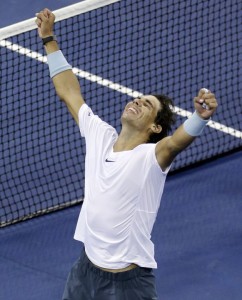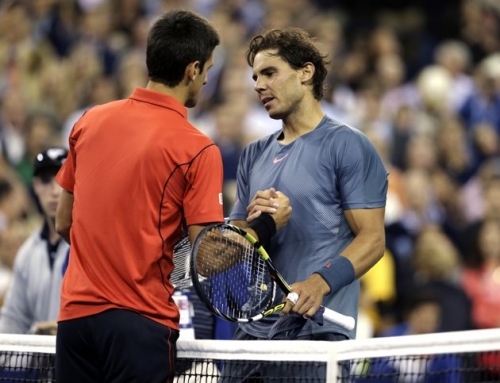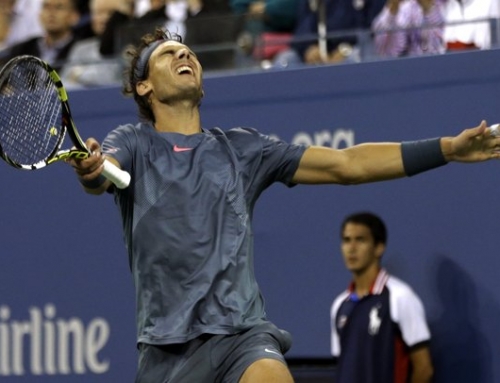 Before the semifinals started, some were asked who had the better chance for the upset: Richard Gasquet or Stan Wawrinka.
Before the semifinals started, some were asked who had the better chance for the upset: Richard Gasquet or Stan Wawrinka.
Almost unanimously, it was Stan Wawrinka. Of the two, Wawrinka actually had tour wins over Djokovic, admittedly, only two, and admittedly, only early in their career. Gasquet, by contrast, was 0-10 against Nadal dating back to the days when Nadal was just new to the tour.
More than that, Wawrinka has a tougher style, having already pushed Djokovic to 5 pulse-pounding sets earlier in the year at the Australian Open. Gasquet, by contrast, would often to lose to Nadal in lopsided sets. Gasquet, in any case, is a far more accomplished clay courter, and most of their recent meetings have been on clay won, naturally, by the king of clay. But even their most recent meeting on hard courts, one that dates back to the 2009 US Open, was a lopsided 62 62 63 win for the Spaniard.
Add to that, Novak Djokovic has not played 2013 as well as he did in 2012. Not that he’s playing poorly, by any stretch, but he’s not nearly as dominant. He’s cleaned up his game since Montreal, the last time he played decent tennis (he lost early in Cincy).
Meanwhile, Wawrinka came off several solid wins: over Baghdatis, over Berdych, then a nice straight set win over a subpar Andy Murray, the defending champ.
The match played very much like it did in Australia with Wawrinka taking control of the first set, then up a break in the second set before Djokovic came back to take the second set. Unlike Australia where Djokovic then took the third set, the Swiss came back to take set 3.
The main difference for Wawrinka is just an overall improvement in his game, esp. his ability to stay in rallies, but then use his fabulous one-handed backhand either to be patient, or to attack. The main problem with Wawrinka’s game, probably the key that will keep him outside the top 3, is the ability to hit the big shots more consistently. In a way, both Nadal and Djokovic thrive off superb defense, despite an ability to take offense when it comes.
Wawrinka tried to hang in against the world number 1 early in the fifth set, in a marathon 20 minute plus point that lasted around 30 points. Although Stan held serve, it was a win of a battle, but the loss of the war against Djokovic. Fortunately, for the Serb, with the final moved to Monday, he gets an extra day of rest.
In the later match, it was Richard Gasquet facing Rafael Nadal. Gasquet has been trying a different style, one that combines being more patient from the baseline, with selectively attacking. Historically, Gasquet has had two problems. He hit way behind the baseline (which he still does), but because his stamina wasn’t so good, he couldn’t last in long matches. Gasquet appears to have improved his conditioning which opens up the playbook for him. The Frenchman can now engage in longer rallies, as he did against Ferrer, and wait for more favorable shots.
Of course, it’s one thing to play patient against Ferrer, and it’s another to play patient against Nadal. Because Nadal has the ability to take over a point, especially off a floating middle ball, it’s difficult to merely rally with Nadal. Most players find that they must be aggressive against the world number 2. Witness Kohlschreiber’s fourth round match against Nadal. He used a fast serve, and a desire to open up the court using angles from the forehand, to pick off a set from Nadal.
Still, even Kohlschreiber struggled on the return game, and could not break Nadal in any of his serve games.
Gasquet got broken early on in a rather passive semifinal. That break was enough for Nadal to hold serve throughout the first set, and win it 6-4. Nadal would get another early break in the second set, but Gasquet would then break back in the first break Nadal has had since the start of the tournament. The set would go to a tiebreak, but Gasquet would make enough errors that Nadal took the tiebreak comfortably. Finally, Nadal would break early and late to take the match, 6-2
If Gasquet had a problem, it was trying to be aggressive successfully. He was fine on the patient aspects, playing longer rallies, and kept in the points reasonably well, but when he decided to pull the trigger, he’d find himself netting the ball. This is partly the problem with many players trying to up their level of aggression. They make a few too many errors.
As we reach the finals, many of the matches the fans had hoped for failed to materialize. Isner lost to Kohlschreiber, so he didn’t play Nadal. Federer lost to Robredo, so he didn’t face Nadal either. For that matter, Ferrer lost to Gasquet, so he didn’t play Nadal. Murray lost to Wawrinka, so he didn’t play Djokovic.
But, the top two seeds made it, and so the finals, to be played on Monday, is what the seeds and fans expected.





![[US Open Men’s Final] Can Djokovic beat Nadal in the finals?](https://www.essentialtennis.com/wp-content/uploads/2013/09/20130909djokovic-500x383.jpg)
![[US Open, Day 11, QF] Wawrinka upsets Murray in straight sets to make first Slam semi](https://www.essentialtennis.com/wp-content/uploads/2013/09/20130906wawa-500x383.jpg)
![[US Open, Day 10, QF] Nadal shuts out Robredo to reach semis](https://www.essentialtennis.com/wp-content/uploads/2013/09/20130905nadal-500x383.jpg)